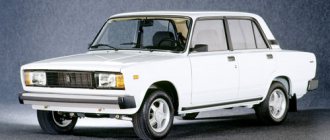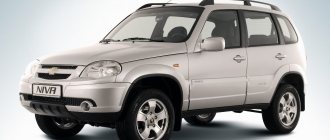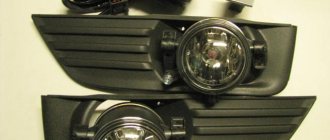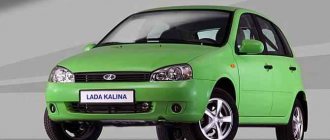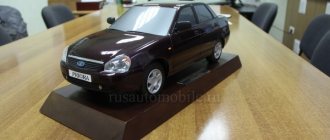Although today there are several options for replacing standard lamps in headlights to modernize and improve car lighting, xenon remains the most common and in demand. Compared to traditional halogen lamps, gas-discharge xenon lamps shine brighter and have a longer service life, since the spiral of a conventional lamp fails much faster from vibrations.
In turn, LEDs, which were originally supposed to replace xenon, also have a number of certain disadvantages. As a result, xenon car lighting has been and remains the most popular. Moreover, the optimal solution is a combination when the headlight is modified and xenon lenses, bi-xenon lenses, etc. are installed in conjunction with xenon.
At the same time, not all car enthusiasts know what bi-xenon is in a car, the principle of operation, the pros and cons of this solution, as well as how to choose lenses for car headlights, etc. Next, we will look at what bi-xenon and bi-lenses are, as well as what nuances you should pay attention to when upgrading and improving the light of your car’s headlights.
Now, actually, what is bi-xenon?
Time does not stand still and xenon has been replaced by more advanced and high-tech lamps called bi-xenon. Bi-xenon lamps, as you understand from the name, are the successors of the same xenon, but unlike their predecessors they have a number of significant differences. Recently, bi-xenon has become more popular than xenon, and there are several reasons for this, mainly related to design features. Bi-xenon has a more complex structure and functionality, but at the same time it allows you not to separate the low and high beams, using instead only one light bulb. Xenon lamps are most often used in cases where there are two separate lamps for the high and low beams.
Bi-xenon differs in that it can switch the lamp's glow mode, thereby producing either low or high beam, depending on the need and the road situation. Bi-xenon headlights are capable of changing the geometry of the light flow and its boundary, through a special curtain or bulb. Moving, the curtain is able to change the light from high to low and vice versa in a matter of seconds, without wasting time igniting gas-discharge lamps. The design of bi-xenon headlights most often uses an electromagnet, which actually sets the bulb or curtain in motion.
Bi-xenon lenses: features
Let's move on. Bi-xenon lenses, unlike a regular bi-xenon kit, also have certain features that need to be taken into account. First of all, the light from the lens is directed quite narrowly. This means that the glass of the headlight itself must be completely transparent, without a pattern of corrugated stripes. The presence of reflectors in the headlight, etc. is not allowed.
Let us also add that the installation of such lenses will require serious modification of the optics itself. As a rule, buying a lens for a headlight, especially of good quality, is not so easy. Then the headlight itself has to be heated so that the sealant becomes elastic, after which the head optics can be carefully disassembled. Next, you need to correctly integrate the lens into the headlight, select a mask for the lenses, resolve the issue with dimensions, etc.
Afterwards, it is important to reassemble the headlight properly (using the old factory sealant or applying a new one). After this, you need to allow the sealant to dry. It is quite obvious that such work requires certain knowledge and skills, as well as equipment. It is noteworthy that even professionals who install xenon and lenses sometimes find it difficult to give a 100% guarantee that the headlight will not start to sweat. If this happens, then it is necessary to re-disassemble, restore the tightness and reassemble the headlight.
Operating principle of xenon and bi-xenon lamps
To understand the principle of operation of bi-xenon and xenon, it is worth understanding the features of each of them.
1. Xenon.
A lamp containing an inert gas inside. The main difference from conventional light bulbs is the absence of an incandescent filament.
The operating principle is simple and ingenious. Inside the lamp is xenon gas and a pair of electrodes. A high voltage discharge appears between them, which causes the gas to glow.
As a result, a bright beam of light in a certain direction appears. It turns out that the main source of light is gas.
In more detail, inside a glass container the size of a match head contains a mixture of metal salts and an inert gas (xenon).
A high voltage discharge appears between the electrodes, which are placed in the flask, which contributes to the appearance of a bright glow of the mixture.
The main advantage of this design is the minimum energy consumption with high-quality lighting.
The complexity of xenon lies in the organization of the electrical network. The principle of operation is simple, which cannot be said about the construction scheme.
To start xenon and create a discharge between the electrodes, a voltage of 25,000 volts must be created. To guarantee combustion, it is necessary to support an alternating current with a voltage of 330 Volts and a frequency of 330 Hertz.
That is why, when installing xenon headlights, you cannot do without installing additional components, one of which is the ignition unit.
The main advantage of xenon is the absence of a spiral. But such a distinctive feature led to the emergence of a new problem - blinding drivers of oncoming cars.
In halogen lights the circuit is simpler. There, in order to avoid glare, it is worth switching the filaments, changing the mode from far to near.
In the case of xenon, the problem is solved by installing an additional screen that cuts off the “extra” light beam.
In addition, bi-xenon is in great demand. It allows you to switch to low (high) beam without losing the quality of road lighting.
2. Bi-xenon.
This lamp is considered one of the varieties of classic xenon.
The main feature is the presence inside of a mechanism capable of changing the direction of radiation.
We are talking about a metal curtain moved under the influence of a magnetic device. Due to the action of the magnet, various zones of the bi-xenon lamp are opened.
The principle of operation of a bi-xenon lens is as follows. A D2S series bulb (lamps of this type are mounted in xenon lenses) directs a beam of light onto an oval reflector.
The latter reflects the light towards the lens, which receives the flow from the reflector and distributes it. After this, the curtain blocks part of the light to create a “near” mode.
Switching helps to obtain uniform light with clear boundaries, without “extra” flare at the edges.
Principle of operation
Xenon headlights use an inert gas, which glows due to two electrical contacts on different sides. When high electrical voltage (several thousand volts) passes through the inert gas that fills the lamp, it begins to glow. The battery, as you know, produces only 12 volts, and this voltage is converted by the ignition unit, also called a pulsed “ignition device”. The glow of gas-discharge lamps is not discrete, but constant. This creates a bright source of diffused light.
If you add curtains, the light can be directed to a specific place, and it will become directional.
The color of xenon glow directly depends on its temperature:
- 3000 K - yellow tint. This xenon is well suited for fog lights.
- 4300 K - golden light. Will provide the brightest and longest beam of light.
- 5000K is standard white light.
- 6000 K - white-blue tint.
- 8000 K - bright blue glow.
- 10000 K - dark blue color with a purple tint.
- 12000 K - violet-lilac glow.
The most common xenon headlight bulbs produce standard white light. In second place is the white-blue shade.
What it is?
As you can easily guess from the name, bi-xenon lenses are an improved version of regular xenon. One of the main disadvantages of HID lamps is that they only provide low beam, while standard halogen headlights are used for high beam. Bi-xenon bulbs, in turn, can emit both types of light (due to the presence of a special curtain or toggle switch), which is their main advantage. This is what explains the prefix “bi” in the name of the equipment, which indicates the presence of two functions at once. At the same time, this type of lens retains all the advantages of the xenon analogue, namely:
- long service life (several times longer than halogen);
- bright lighting at night (allows the driver to detect obstacles on the roads much earlier);
- low glass heating (which is especially useful if you often have to deal with temperature changes) and dirtiness of the headlights.
For all these advantages, potential owners will have to fork out a lot, and also tinker a lot with installing light bulbs on the car.
What is xenon
In the automotive industry, xenon lamps began to be used relatively recently, from the beginning of the 90s, although they were invented half a century earlier - the first working example was presented by Osram in 1951. At first, they were used primarily in film projectors, since they generated bright light in a spectrum close to natural daylight. In fact, all modern digital and film film projectors use xenon lamps, the power of which can reach an incredible 15 kW.
What are these lamps? Their operating principle is based on the formation of a powerful electric discharge in a gas atmosphere, accompanied by a glowing effect. That is, xenon lighting technology is a type of gas-discharge lamps, and as the main agent they use, as the name suggests, inert xenon.
And if in lamps the same effect is achieved by passing current through a thin metal filament, heating the latter to a state of bright glow, then in xenon analogs, connecting two contacts is not required. The light is generated by an electrical discharge like lightning.
The main advantage of such lamps is that they generate a luminous flux with fairly stable characteristics, since the gas environment in the bulb remains constant, and the ignition unit generates a voltage that lies within a strictly specified range.
The main feature of such devices is that the glow does not last long, so for it to be constant, it is necessary to constantly apply high-voltage pulses to the electrodes of the lamp. But since the car’s on-board network is rated at 12 V, an electronic ignition unit is used to generate the required current, in which, due to the presence of a capacitor and other electronic components, electricity is accumulated and subsequently discharged.
The absence of an incandescent filament is a definite plus, since the low resource of the evaporating metal is the main reason for the gradual withdrawal of classic Ilyich light bulbs from the market.
But if in everyday life it is difficult to contain the advance of LED lighting devices, then in the automotive industry xenon lamps feel quite confident. True, the inability to change the direction of the light flux somewhat limits the scope of their application - they cannot be used as a source of low and high beam - either one or the other. The most commonly used combination is: low beam - xenon, high beam - halogen (the use of two xenon headlights is not the best option both in terms of cost and due to the lack of free space).
The advent of bi-xenon headlights also solved this problem.
What are bi-xenon headlights?
Xenon lighting - lanterns or headlights in which special gas-discharge lamps are installed; they do not have an incandescent spiral. Due to the design features of the lighting elements, a directed beam of light is created; to improve the efficiency of the luminous flux, xenon is used together with lenses. The main advantages of xenon headlights over halogen ones:
- directional flow of light;
- economical energy consumption;
- brighter lighting.
The directed light flux dazzles oncoming drivers less because it is directed towards the road and does not scatter. Xenon lamps are mainly used for low beam; a bright beam beam is not always advisable to use for distant lighting. Bi-xenon is used as a combined light (the lamps switch to both high and low beam), the light flux is switched by a moving electrode inside the bulb. Also, the “high/low” change can be done by installing a moving curtain or screen; often standard bi-xenon optics are equipped with an automatic headlight control system.
What temperature is everyone talking about?
The most significant parameter of a gas-discharge lamp is its glow temperature. In stores there are lamps with a glow temperature from 3000 to 8000 K (Kelvin). It is better to install lamps with a temperature of 4300 - 5000K in headlights. Their light is closest to daylight. As a result, the eyes become less tired and the road is well illuminated. The main advantage is that wet asphalt is well illuminated.
With increasing temperature, the glow first becomes white (6000K), then turns into a blue spectrum (8000K). It is not worth installing the “hottest” lamps, since they illuminate the road very poorly, and even more so when it is wet. The difference in illumination is clearly demonstrated by numerous video and photographic materials on the Internet.
We install bi-xenon instead of a regular H4 halogen lamp with our own hands
Inclusion in the circuit of a kit with individual relays
The mechanical part of the Bixenon lamp installation process is simple and absolutely repeats the monoxenon assembly method:
- form a hole in the headlight housing for supplying additional wiring;
- install a Bixenon lamp instead of the standard halogen one;
- secure the ignition units in the immediate vicinity of the headlights.
The first installation of bi-xenon H4 with your own hands often causes difficulties in organizing the connection diagram. The autonomous configuration does not provide for the presence of life support elements common to the two lamps - therefore, the installation process can be carried out sequentially. According to this principle:
- the lamp is connected and tested on one headlight;
- manipulations are carried out with the wiring on the second head lighting device;
- the final test is carried out.
A kit with an individual relay usually contains the following electrical elements:
- 2 ignition blocks;
- 2 relays;
- 2 switching harnesses with soldered diodes;
- 2 lamps.
According to the connection diagram for the bi-xenon kit with an individual relay, the procedure for carrying out the operation is as follows:
- a wiring harness with a diode is connected to the connector coming from the lamp and responsible for moving the screen;
- the standard wiring block, previously connected directly to the H4 socket, is connected to the three-pin connector coming out of the harness connected above;
- the connection harness is connected to the relay;
- the electronic key is connected to the network by attaching the positive terminal to the battery and the negative terminal to ground;
- The ballast (ignition unit) is connected to the relay;
- The power taps of the lamp are connected to the blocks of the ballast.
Inclusion in the circuit of a kit without relay devices
In kits without a relay, the diode is embedded directly into the three-pin power supply block. The connection diagram is absolutely identical, with the exception of operations associated with the electronic key: the power connector of the ignition unit goes directly from the connection with the standard block.
How to install it yourself
Installing a new lens into a headlight with your own hands is not that difficult. The main difficulty is to find and purchase lenses with the desired type of base. Sometimes it happens that for a certain car model it is impossible to find the design you like with the correct base. In this case, adapters come to the rescue. If you have already chosen and purchased optics, the matter remains small.
This is what new lenses for car headlights look like
Required Tools
Before you begin installing the lens, prepare all the necessary tools. These include:
- A set of screwdrivers of different diameters (make sure they include slotted and Phillips);
- an industrial hair dryer or other source of high temperature (sometimes a regular oven is used, which is found in almost every apartment);
- pliers;
- Gloves to protect hands.
Installation process
After all the choices, thoughts and preparations, it's time to install new lenses.
First of all, you should remove the headlights. This process varies depending on the car model. As soon as the headlights are in your hands, they need to be wiped off from dust and dirt, and then disassembled. A strong sealant will not allow you to easily separate the glass, so the headlight must be heated at a temperature of 300 degrees. Usually an industrial hair dryer is used for this, but if you don’t have one, you can use a regular oven. To be on the safe side, cover a baking sheet with a towel and let the headlight warm up for 5-7 minutes.
The next step is glass separation. This can be done using a wide screwdriver. If you've heated the headlight correctly, this should be fairly easy to do. Don't forget to wear protective gloves.
This is what the headlight looks like after disassembly
Next, you need to remove the reflector and all its fasteners. This is necessary when installing bilens. After that, insert the lens and pass the wires through the hole for the standard lamp. Fix it firmly, if necessary, use an adapter.
Now you can start assembling the headlight. Before returning the glass, clean the inside thoroughly. Apply a thin layer of sealant to the housing. If the disassembly and installation process took a long time or you were distracted, and during this time the headlight had time to cool down, warm it up slightly. After this, install the glass in its place and return all the necessary external elements. It will take up to 8 hours for complete drying. However, to be on the safe side, postpone installing the headlight until the next day.
A day later, the updated headlight is ready. All that remains is to return it to its place in the car body and connect the power.
Lens Adjustment
However, installing the lens is only half the battle.
It is very important to adjust it correctly. You've probably seen cars on the roads with a bright beam of light that blinds everyone around them.
You might even think that the driver confused the low beam with the high beam. In fact, most often these are just incorrectly installed xenon lenses. With bright light sources, even a slight deviation can lead to distortion of the light output.
Too bright xenon can blind oncoming drivers
Therefore, after installing the lenses, do not be lazy and adjust your headlights. To do this, you need to take a few simple steps.
Find a vertical wall and an empty section of road in front of it
It is important that the road is smooth, without noticeable holes or hills. Park the car with its nose as close to the wall as possible. Draw a straight vertical stripe down the center of your car. Move at least 7 m away from the wall. Measure the distance from the ground to the lens. Write down the numbers you get. Measure the distance from the lens to the center axis of the machine
Write down the numbers you get. Determine a point on the wall that is exactly at the level of your headlights. To do this, use the numbers from points 5 and 6. Draw a horizontal strip exactly 5 cm below this point. Draw two perpendicular stripes. The intersection point should be the number from point 6. If the headlight has two separate lenses for low and high beam, measurements must be taken for each of them. Accordingly, the wall will have two horizontal and two vertical stripes.
To make it clearer how and where to draw lines, let’s look at the situation using an example. Let's say the lenses are located at a height of 30 cm from the ground. The distance from the lenses to the center of the car is 70 cm. This means that the horizontal stripe on the wall should be located at a height of 25 cm, and the vertical stripes perpendicular to it should be 70 cm from the axis drawn at the very beginning.
You need to adjust the headlights so that the beam of light falls exactly on the point where the stripes intersect on each side.
If this process seems too complicated to you, it makes sense to entrust it to professionals, as well as installing the lens itself. Service specialists will do this efficiently and in a short time.
Advantages and disadvantages
Let's look at the main pros and cons, and try to draw conclusions about how xenon differs from bi-xenon. The positive aspects of a xenon lamp include: high light intensity, device security, and modern technology.
There are not many disadvantages, including the high price of the lamps due to the complex design. According to reviews from car owners, the strong brightness of such devices interferes with oncoming traffic.
The bi-xenon lamp is slightly better than xenon due to the presence of two operating modes, as well as the ability to change the lighting area. Adjusting the intensity of the glow can also be considered an advantage of such light sources.
The disadvantages are basically the same as those of xenon lamps, but with one difference. Thanks to the curtains, there is no glare from oncoming traffic.
The last drawback applies to both types of light sources. Due to the fact that their operation involves high voltage, operating a vehicle with a faulty xenon or bi-xenon lamp is prohibited. If this rule is not followed, there is a danger of elements catching fire. To avoid this, you should contact a service station in a timely manner.
Xenon allowed or not
To the question whether xenon is allowed, one can give an unequivocal answer: yes, it is allowed for use in Russia. It is only important to understand that its installation is allowed only if the requirements of compatibility of such lamps with car headlights are met and the availability of such additional equipment in the form of automatic headlight leveler and washer.
But to the question of whether it is possible to install xenon on domestic cars, you can also answer unequivocally: no. Their optics are not designed for such modifications. Moreover, third-party manufacturers also do not produce certified headlights for them that allow the use of gas-discharge lamps.
At the end of the article, I would like to address those who are installing or are planning to install “collective farm” xenon in their cars:
- Show at least a little respect for other road users. You are blinding;
- you are putting hundreds of lives in danger, including your own.
All your arguments like “my xenon doesn’t blind anyone, I checked it myself” are complete nonsense. Watch a video of the consequences of being blinded at high speed.
If it is so important for you to have blue headlights, there are xenon and halogen replacements on sale with increased light output and a blue glow. Better install them, at least it's safe.
What else is worth reading
Adaptive lighting
Parktronic
Car light alarm
High pressure headlight washers, operating principle
Are xenon and bi-xenon allowed in Russia?
Even now there is no clear answer to this question. Different sources have different interpretations of regulatory documents. Previously, uniform requirements were imposed: the sources of light radiation must be standard lamps and headlights provided by the manufacturer
.
Approximately the same requirements were imposed on all significant equipment that affects traffic safety: steering, chassis, and braking systems.
Then the requirements were softened a little: it was allowed to install lamps that corresponded to the types of headlights, that is, the headlight markings must include the international classification with the symbol D. However, how to prove which headlights were included as standard remained a question.
A little later, the requirements were relaxed even more: xenon could be installed if there was a headlight cleaner device plus an automatic headlight luminous flux controller. When conducting a technical inspection for these non-standard devices, appropriate documents were required indicating their installation at a service station or workshop with the appropriate certificates. That is, in fact, independent conversion of lighting to xenon remains prohibited.
Most car owners return the “original” light before the technical inspection, without bothering with installing additional ones. equipment. In addition, installation of a headlight cleaner and light flow regulator at a certified service station costs more than 15,000 rubles.
As for bi-xenon, it’s generally difficult. Essentially, it can only be installed on a car that is equipped with standard bi-xenon lenses. That is, there is only one option left: if some models of your car are equipped with bi-xenon, namely, they “forgot” to install them in your car, then you can install bi-xenon lenses.
Traffic police officers know well which car models have xenon, but xenon itself on a dark road reveals itself a couple of kilometers away. When stopped, the driver will have to document his case.
In conclusion, I would like to wish: you don’t have to imagine yourself smarter than the engineers who were developing your car model - if the installation of xenon and bi-xenon is not provided for by the manufacturer, then abandon this idea! Nobody needs the “collective farm” - respect the drivers who are coming towards you.
Video - what is the difference between xenon and bi-xenon:
May be of interest:
Choose a DVR: an indispensable gadget for the driver
Scanner for self-diagnosis of a car
Select any auto chemicals for your car
Some drivers prefer a DVR in the form of a mirror
Advantages and disadvantages
When properly installed and adjusted, the light from xenon/bi-xenon does not blind other drivers and provides high-quality illumination of the road surface and the side of the road. In fog, rain, and snowfall, visibility from such lamps is better. The brightness of xenon reaches 3200 lm (lumens), which is 2 times more than that of halogen lamps. Xenon and bi-xenon lamps are economical: their service life is about 3000 hours, and low energy consumption minimizes the load on the generator and fuel consumption.
Disadvantages:
- Difficult to install yourself. To legally install such lamps in headlights, you need to study the technical characteristics of the car (installation of xenon and bi-xenon is not possible in every model). Check the compatibility of the equipment with the car headlight.
- Re-equipment of headlights not intended for the installation of xenon/bi-xenon is carried out in specialized centers. The cost of such modifications is quite high. In addition, the approval process with the traffic police takes a lot of time.
- Expensive components: control units, ignition units, purchase and installation of the bi-xenon itself.
- When buying a used car with factory or modified xenon, you need to check the permitting documents for optics. For illegal xenon in Russia you face a fine or deprivation of your rights.
The color of the light beam from the lenses depends on the type of lamp.
Differences between xenon and bi-xenon
As you already understand, the difference between xenon and bi-xenon lies in the possibility of using different operating modes.
Xenon optics are usually used for the low beam mode of headlights, less often - as a source of formation of both beams, both low and high, but in this case you will need not two, but four sets, which doubles the cost of such systems, which is already quite considerable. Of course, in this case the lanterns will be double, designed to accommodate separate lamps, and this is also a problem, since it is extremely difficult to maintain the same size of such a lantern.
Bi-xenon headlights do not have this drawback - they can be installed in a standard single headlight, which makes them a more universal solution. The concept of universality here is conditional, since if you install bi-xenon yourself, you will still have to finish and redo a lot, and you will also need to legalize such a modification of the head light, which is also quite troublesome and expensive.
But if we talk about cars, the top configurations of which include the installation of xenon/bi-xenon, then here the owners of more mundane cars with a rather poor configuration have much more possibilities for light tuning.
Light car tuning
As for the technical characteristics of different types of lighting devices, here the difference between xenon and bi-xenon is practically leveled out, but compared to halogen optics, the differences are noticeable.
In particular, in terms of light temperature, xenon is significantly better than halogen lamps: while the latter provide the generation of light flux with a temperature in the range of 3-3.4 kK, then for xenon analogues this figure is significantly higher: 4.3-5.0 kK.
At night, the optimal light should have a white or yellow glow. The shift in color temperature up the scale is characteristic of the blue spectrum, which is more tiring for the driver's eyes because it involves driving under greater stress.
This is exactly what happens with both xenon and bi-xenon lamps - the color temperature can reach values of the order of 6000 Kelvin. At the same time, the intensity of the scattering of the light beam also increases, which can be explained by an increase in the oscillation frequency of the light wave.
A conventional converging lens is unable to cope with the need to focus the scattered light flux into a clearer and more focused beam, so gas-discharge lighting devices use a metal screen that copes well with the task.
However, such subtleties are not so important, because in terms of brightness, color and other characteristics, the differences between xenon and bi-xenon are not fundamental. But there may be incompatibility at the base level. Users note that bi-xenon optics last a little less, which can be associated with the more complex design of these lighting devices.
In addition to the mode of use, the conceptual difference between these types of light optics is cost. Regular xenon kits are much cheaper, but it is worth considering that you will have to solve the problem of high beam - perhaps by purchasing a second xenon kit, which will be more expensive than a bi-xenon with its monolens.
Recently, the market has offered a more elegant solution - so-called bilenses, which allow you to combine both types of beam, high and low, in xenon.
In general, a car owner intending to replace standard halogen optics with gas-discharge optics must take into account the following factors:
- xenon kits are usually used to provide low beam operation;
- dual-mode bi-xenon - an alternative to combined halogens (such optics are considered the most common today);
- Bilens xenon may be preferable to bi-xenon, but this is a technology that has not yet been well proven.
We also note that it is difficult to externally distinguish xenon from bi-xenon by the bulb itself - they are the same, but the bi-xenon cartridge is slightly larger, as is the number of wires.
How to legally install non-standard xenon
Unpleasant meetings with traffic police officers, fines and deprivation of a driver’s license can be avoided by equipping the car with xenon or bi-xenon lamps in accordance with the technical characteristics of the car.
GOST R 41.99-99 (UNECE Rules No. 99) clearly regulates the marking of gas-discharge light sources. Xenon and bi-xenon are marked on the base with the letter “D” for headlights of DC (xenon low beam), DCR (bi-xenon), DR (xenon high beam) types.
Trust the installation of lamps to specialists.
Entrust the installation of lamps to qualified craftsmen who can guarantee the legality of the installation and issue permits.
Which company to choose
One of the most important points is the selection of appropriate equipment for installation.
If possible, you should only purchase xenon kits from reputable companies. This will allow you to avoid many difficulties and problematic issues.
At the moment, the following kit manufacturing companies are the most popular and famous:
| Light Way | relatively inexpensive Chinese manufacturer, a compromise between price and quality |
| Omegalight | Korean manufacturer, relatively inexpensive and durable |
| Silver Star | production is established in China, but the manufacturer has established itself as a manufacturer of high-quality light |
| MTF | Moscow brand, produced in Korea |
We install xenon with our own hands
Do not neglect safety precautions when installing xenon, as you can not only damage the equipment, but also seriously injure yourself. So make sure your hands are dry and oil-free.
It is also forbidden to touch the xenon lamp bulb with your hands. In case of contact with it, it is necessary to degrease the surface with alcohol.
Before starting installation, be sure to disconnect the positive terminal of the battery. You must also remember that xenon at the moment of startup produces a voltage of 23 thousand volts!
Once you are convinced that the process is safe, you can proceed directly to the installation. First of all, we will remove the old halogen lamps and replace them with xenon lamps. To do this, you need to remove the protective cover from the headlights. Disconnect the contact wires from the lamp and take it out. In order to safely remove the light bulb in some cars, you need to release the spring that secures it. We carefully remove the new xenon lamp from the protective bulb and insert it into the hole. Remember not to touch the flask with your hands. If you had a spring that fixed the halogen lamp, then you need to crush it. The fact is that the wires from the xenon lamps will need to be pulled through it and then brought out through a plug into the engine compartment. From the battery side, this will be a little more difficult to do, since it will partially block access to the headlight. Therefore it is better to remove it. After installing the bulbs, connect the terminals from the ignition unit to them. The next step is to make holes in the headlight plugs to run the wires through. There are two types of plugs - rubber and metal. We cut out a hole in rubber ones with scissors; in metal ones we will have to drill. It is better to use a milling cutter for drilling. The optimal hole diameter is approximately 25 mm. The stage of installing the light bulbs was the most difficult and time-consuming. Next, you need to select a location to install the ignition unit. It should be located in close proximity to the headlights so that the wires do not pass under tension. It is better to choose a place that is protected from moisture, dirt and heat. In general, high-quality ignition units should be sealed, but some manufacturers take little care of this. If you still cannot find a protected place, then simply wrap the block with electrical tape or tape. This will increase his safety, albeit partially. The ignition unit itself can be secured using clamps, double-sided tape, or attached with screws. Next, we connect the wires from the ignition unit and from the xenon lamps. Here, each wire has its own color, so it will be difficult to mix it up. You also need to connect the ignition unit to the standard electronic system. To do this, we draw another wire from the ignition unit to the connector where the halogen light bulb was connected. We repeat the procedure with the second headlight, the process is similar - we install xenon lamps, an ignition unit and connect the wires. We secure all the wiring with clamps so that it does not dangle. We twist the excess wire into a ring.
It is better to check the correct connection using the diagram, which will definitely be in the instructions. You can also use this xenon connection diagram: Some difficulties arise when installing xenon with your own hands on cars with on-board computers. If the xenon does not function correctly when igniting or during lighting, it is recommended to install a voltage relay. It will stabilize the load on the wiring at the moment when the headlights turn on.
This video explains how to install xenon lamps with your own hands. Lamps manufactured by IL-Trade, color temperature 4300K with H7 base.
Let's sum it up
Taking into account the above information, it becomes clear that when switching from halogen to xenon, the optimal solution is to first buy lenses for the headlights and modify the standard optics. At the same time, the desire to save money and limit yourself to installing a conventional bi-xenon in a headlight not intended for this type of lamp may often not bring the desired results.
The fact is that on many cars it is impossible to properly adjust xenon headlights without lenses. As a result, severe blinding of oncoming car drivers will inevitably occur, which often becomes the cause of conflicts on the road, accidents and other incidents.
We also recommend reading the article about what DRLs are, as well as how to select and install daytime running lights (DRL) on a car. From this article you will learn about the features of selecting DRLs, as well as what nuances you should pay attention to.
Finally, we note that when purchasing xenon kits, lenses, lens masks and other equipment, it is important to ensure that the products are original. For example, there are a large number of counterfeits on the market, not only of well-known brands (for example, Hella, Philips or Mitsumi), but also for cheaper kits (for example, Sho-me or MTF Light). For this reason, it is necessary to purchase equipment with a guarantee only from trusted sellers.
It is also recommended that the installation of xenon and lenses be carried out exclusively by professionals, since experienced specialists are able to provide an extended warranty on all work performed. This approach will allow you to avoid premature failures of xenon equipment and get high-quality auto lighting, which will be correctly installed and configured taking into account all requirements, recommendations and possible nuances.
General points
A feature of headlights with lenses is that the flow of light is “cut”, due to which the direction is adjusted. The rays pass only along the horizon and are not transmitted vertically.
The design of headlights with lenses consists of separate blocks. This:
- headlight itself;
- reflector;
- xenon lamp.
The lens is used to focus a beam of light directly onto the road, and this is its main function. Using headlights without lenses is considered illegal.
To ensure that the beam of light is cut strictly vertically, special magnetic “curtains” are used. It is possible to install automatic headlight adjustment.
Initial data
Drivers resort to such tricks in order to improve the appearance of the car and its performance, or to achieve high-quality lighting.
Pros of using lensed headlights:
- increasing the factory characteristics of the vehicle;
- improving the appearance, “tuning” the car;
- high functionality and durability.
However, it should be noted that there are also disadvantages. Installing lenses with xenon lamps in artisanal conditions is considered illegal.
After the lamps are installed, they need to be adjusted correctly. You should entrust the work of installing headlights and lenses to an experienced car service technician.
Why is it installed?
Drivers resort to installing xenon lamps for several reasons:
| For vehicle tuning | Xenon headlights look beautiful, and when installing lenses you can get the effect of “angel eyes” - a rim of LEDs is installed around the lens. It should be noted that tuning is possible using halogen lamps |
| Improved luminous flux | Lenses can be installed together with xenon lamps. As a rule, installation is carried out at special repair stations that have a certificate. Xenon lamps are supplied complete with lenses |
| Factory settings and lamp replacement | On some car models, lenses with lamps are installed at the factory as standard. As a rule, these car models are very expensive, as is a separate package for them. Headlights in modern cars are separate computer systems that have many functions - turning lights, changing the angle of illumination |
The main reason why drivers resort to installing lamps is tuning and improving the appearance of the car.
However, if only tuning is required, you can install lenses on the car on halogen lamps. The luminous flux in this case does not improve.
Often, drivers install lenses with “angel eyes”. It should be borne in mind that lensed optics are not only a decoration for a car. It is necessary to install lamps with lenses to improve any characteristics.
Car service technicians offer a choice - installing lenses with halogen or xenon. The second option is the most preferable due to the fact that the glow of xenon lamps is stronger, especially if a headlight with a reflector is used.
In addition, factory cars most often have halogen lamps with lenses, which allows the light beams to be focused.
Installing lenses requires serious equipment. In addition to the lenses themselves, the headlight must contain sensors, the operation of which allows you to automatically adjust the angle of light.
This is a safety requirement, and violating it is comparable to violating the law and traffic rules. This equipment is very expensive, so it is used only in cars with the maximum configuration.
What is regulated
A traffic police officer has the right to remove such headlights, and the driver will have problems when passing a technical inspection.
To obtain permission to install headlights, you should contact a certified organization. Please note that you may need permission from the traffic police and a complete replacement of the headlights.
Regulatory acts:
- UNECE Regulation No. 99.
- Code of Administrative Offenses – Federal Law No. 195. Article 12.5.
- GOST standard R.41.99 – 99.
- Explanations of the Department for Road Safety dated February 20, 2010 “On the use of xenon headlights.”
These regulations are applied by both drivers and traffic police officers who check cars and seize headlights.
Disadvantages of xenon and lenses in headlights
Even with all the advantages, xenon, bi-xenon and lensed optics have certain disadvantages. First of all, this is the re-equipment of a vehicle, which is illegal if such technologies were not installed regularly at the factory.
Xenon lamps are also more expensive than halogen lamps, ignition units may fail, and other problems with the equipment may arise. It is also important to select high-quality installation kits, as there is a large amount of low-quality equipment on the market.
For example, in cheap kits the units are no more than two years old, the lamps are about a year old, while high-quality ignition units are quite capable of lasting at least 5-7 years or more. When it comes to lamps, original products from reputable manufacturers often last a minimum of 2-3 years.
We also recommend reading the article on how to install and connect fog lights on a car. From this article you will learn how to install and connect fog lights to a car, as well as what subtleties and nuances you should pay attention to during this procedure.
It can also be noted that in winter, xenon lamps, especially in the lens, heat the headlight itself less. In practice, if ice has frozen on the headlights, you need to wait longer for the optics to thaw. In the case of halogen, the headlight heats up faster.
The lenses themselves also tend to “fade” over time, and dust gradually accumulates on them. All this gradually worsens the quality of light, and replacing lamps with new ones does not help. You have to disassemble the headlight itself and change the lenses.






